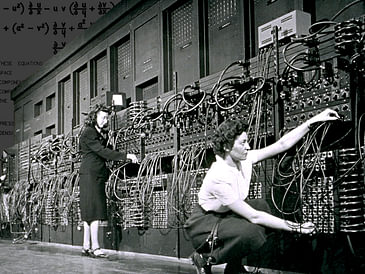In this episode, Shelly is joined by Thomas Haigh, Professor of History at the University of Wisconsin- Milwaukee and author of two books: ENIAC In Action and A New History of Modern Computing. In today’s episode, we discuss a portion of the first chapter of his upcoming book, which puts the story of computing into one place.
A New History of Modern Computing, co-written by Haigh and Paul Ceruzzi, recounts the history of modern computing from 1945 to present day. ENIAC, the first computer to combine electronic speed and automation of looping operations, serves as the starting point for the book. Bullet trajectory during World War II motivated the construction of the project. At that point, a computer was considered an operation title for a person, most commonly women. The operator's role involved configuring the machine by properly wiring the networks. However, ENIAC wasn’t finished by the end of the war to run the intended calculations. By the time it was ready, calculating firing tables only accounted for about 15% of its usage. The availability of memory storage shed light on a whole new approach for building computers. A much simpler model was realized with just one arithmetic unit, rather than the 20 circuits of ENIAC.
There is some confusion surrounding the conflicting information regarding EDVAC and MANIAC circulating online. As clarified by Thomas, John Von Neumann had described a basic idea for a new computer built around a large addressable electronic memory. Groups of engineers worldwide began working along these lines to produce computers on this EDVAC model. The confusion is around the name “MANIAC”, which some people use in reference to The Institute for Advanced Studies computer. However, it has been clarified that MANIAC refers to the Los Alamos computer.
Many groups set out to build these computers, but the engineering was too difficult for most. As a result, many of the early computing projects ended up taking much longer than expected. Recognizing this in 1947, Von Neumann and a team had been put to work to rebuild the flexibility of ENIAC into new computers solving different problems. It was limited in storage but allowed for writing complex programs. The Monte Carlo code was ready in the spring of 1948, but ENIAC needed to be reconfigured to run it. Thomas points out a few of the ways this event had a large impact on the future of computing and coding. As the episode draws to a close, Thomas gives a brief overview of events covered in the book.
Links:
Check out Thomas Haigh’s books ENIAC In Action and A New History of Modern Computing.
ENIAC in Action has an associated website
Learn more about Thomas Haigh.
Send an email to My Nuclear Life or visit their website.
Please leave a 5-star review on iTunes and subscribe to My Nuclear Life wherever you listen to podcasts. Watch out for new episodes every other Tuesday!
Production costs for this episode were provided through National Science Foundation Grants PHY-1713816 & 2011267.




